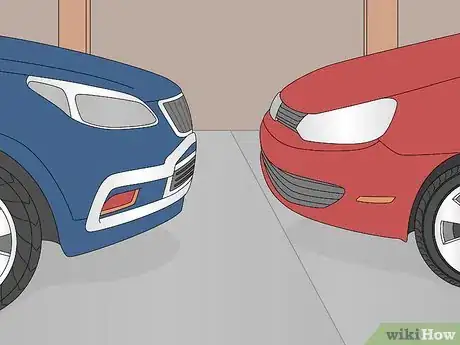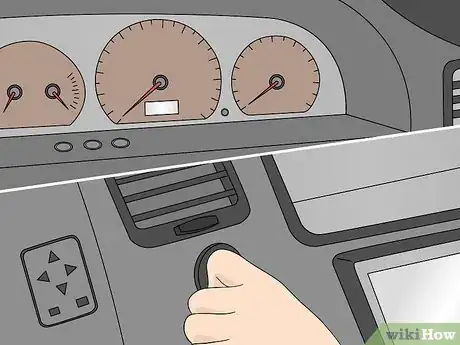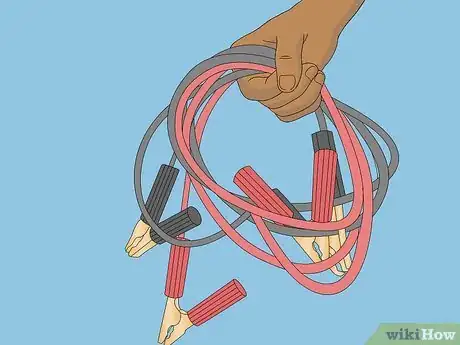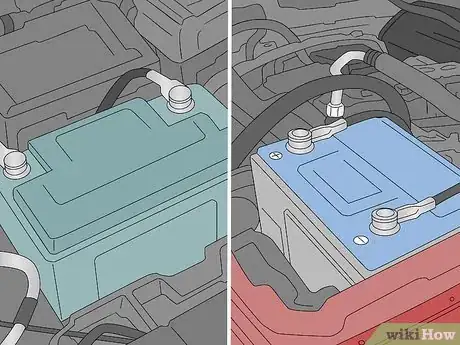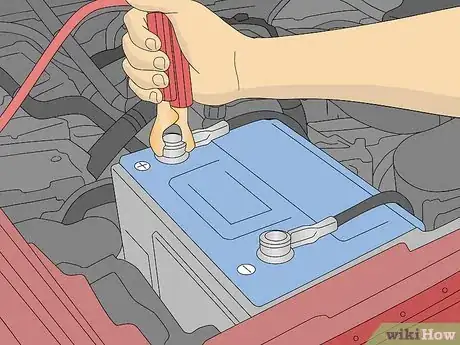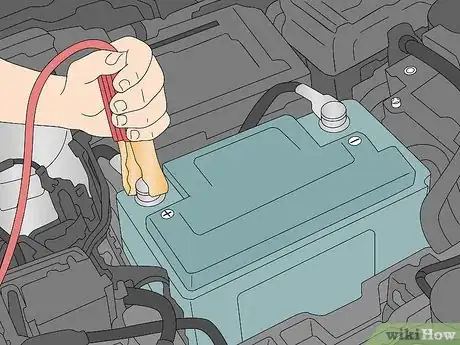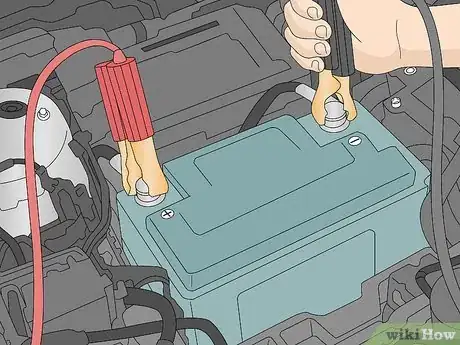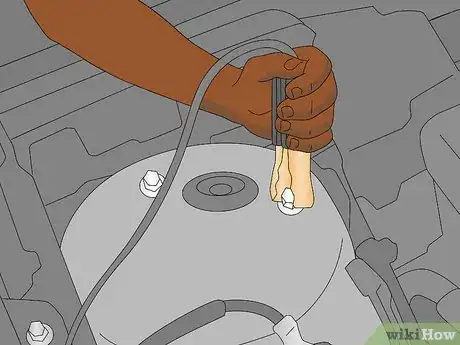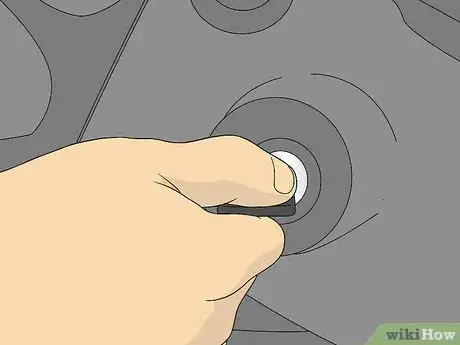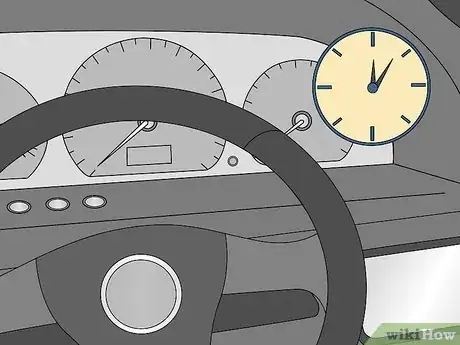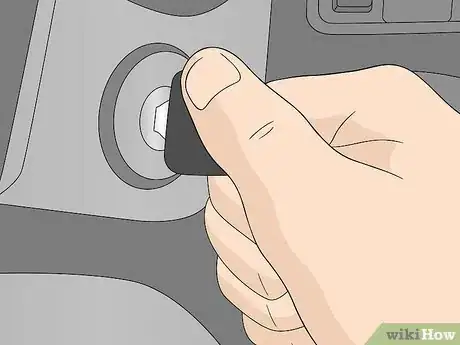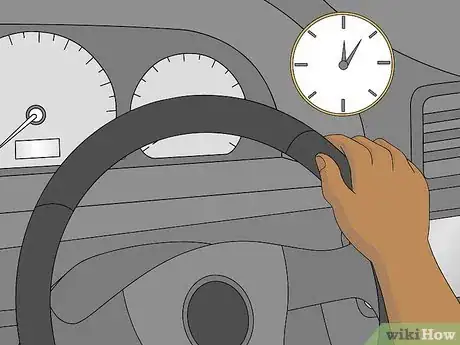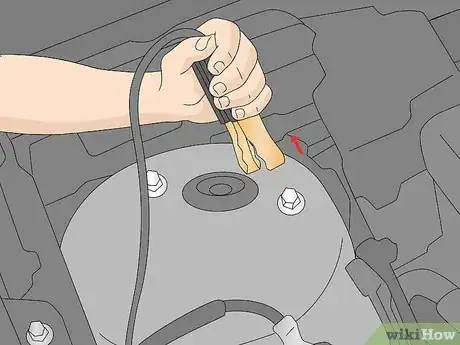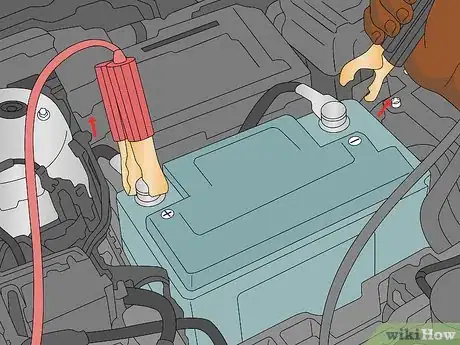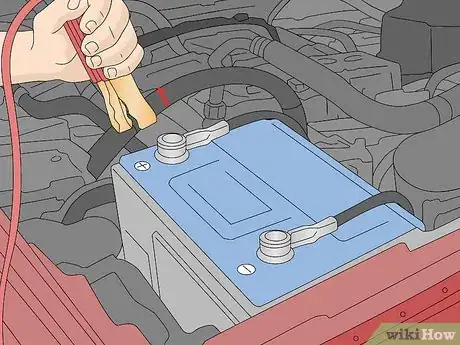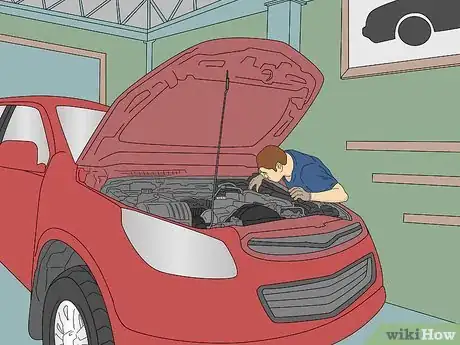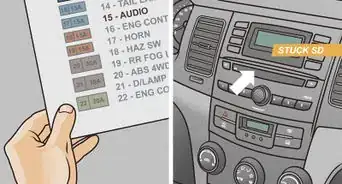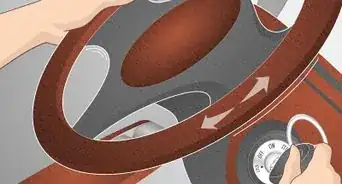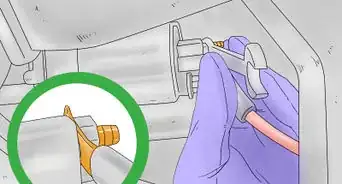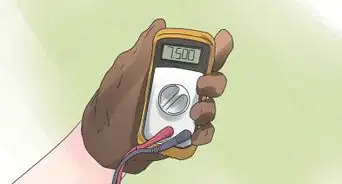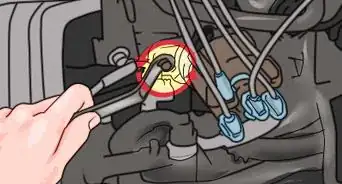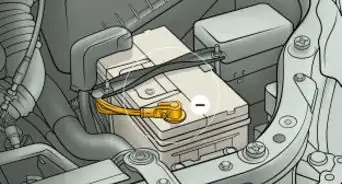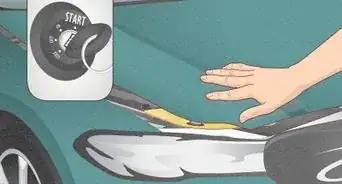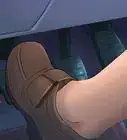This article was co-authored by Duston Maynes and by wikiHow staff writer, Eric McClure. Duston Maynes is an Automotive Repair Specialist at RepairSmith. Duston specializes in leading a team that handles a variety of automotive repairs including replacing spark plugs, front and rear brake pads, fuel pumps, car batteries, alternators, timing belts, and starter motors. Duston holds an Associate’s degree in Automotive/Diesel Technology from The Universal Technical Institute of Arizona and is a Certified Diagnostic Technician and Automobile Mechanics Technician through BMW STEP. RepairSmith received The 2020 Big Innovation Award by Business Intelligence Group and The Startup of the Year by the American Business Awards. RepairSmith was also included in Built in LA’s 50 Startups to Watch and The Business Intelligence Group’s 52 Names Leading the Way in Customer Service. RepairSmith offers in-home services to provide car owners convenient and complete auto repair everywhere.
There are 9 references cited in this article, which can be found at the bottom of the page.
This article has been viewed 150,899 times.
If you’ve tried to start your vehicle but the engine won’t run, your vehicle’s battery may be dead. While this can be frustrating and stressful, rest assured that it normally isn’t a big deal. In most cases, jumpstarting your vehicle will solve your problem. To do this, all you need are a set of jumper cables and a friend or kind stranger with a running vehicle. This process is typically pretty easy—just don’t cross your jumper cables or touch the metal clamps on the cables while you’re connecting them, or you could create dangerous sparks.
Steps
Prep Steps
-
1Park a running vehicle next to your vehicle. You need another vehicle with a good battery to give you a boost. You can park the second vehicle so your hoods are facing one another, or have the second vehicle park next to your hood so the vehicles are parallel. So long as the jumper cables can reach both batteries, you’re good. Just make sure that the vehicles aren’t touching one another.[1]
- If the vehicles are touching, it could potentially short one of the batteries or cause a small explosion. This is unlikely to happen, but it’s better to play it safe and leave a gap between the vehicles.[2]
-
2Turn off all of the electrical components in both vehicles. Double-check your dead vehicle to make sure the lights and wipers won’t come on as soon as the vehicle starts. In the working vehicle, shut the ignition off.[3]
- Once your battery starts charging, you don’t want it to waste energy by powering unnecessary components.
Advertisement -
3Grab a set of jumper cables. The jumper cables will connect the dead battery to the healthy battery so you can borrow a charge and start your vehicle again.[4] Any set of jumper cables will do the trick. If you have a choice, use longer, thicker cables. The longer and bigger the cables, the easier they will be to manuever.[5]
- If you don’t have jumper cables in your trunk and you’re borrowing a set, buy some once you’ve got the current problem sorted out. It’s always a good idea to have jumper cables in your vehicle.
-
4Locate the battery terminals on both vehicles before you start. Pop the hood on each vehicle. The location of the battery depends on the make and model of each vehicle.[6] Look for a small box with two metal bolts sticking up on top. These metal bolts are the terminals. Often, the terminals are covered by black and red covers, and they’re always marked with a (+) for positive, and (–) for negative.[7]
- If there are plastic covers on the terminals, pop them up by hand to access the terminals.
- If your terminals are covered in a white, chalky substance, corrosion may be the source of your problem. Use a battery terminal cleaning tool to wipe this gunk away.[8]
Cable Connection
-
1Connect the red clamp to the positive terminal on the dead battery.[9] Your jumper cables are color coded. Attach one of the red clamps to the positive terminal on the dead battery. The positive terminal may have a red cover on it. If there are no covers, look for (+) under the terminal. Open the clamp’s jaws around the terminal and release the handles to attach it.[10]
- Do not touch the metal clamps of either set of cables together while doing this. You may cause a spark, which can burn hands or ignite flammable liquids in your engine bay. Just keep them separated while you work.
- As an overview here, the order is as follows: red cable to dead battery, red cable to live battery, black cable to live battery, then black cable to ground.
-
2Attach the other red cable to the positive terminal on the live battery.[11] Once one of the red clamps is attached to the dead battery, attach the other end of that red cable to the positive terminal on the donor vehicle. Do this the same way you attached the first clamp. Simply wrap the jaws around the positive (+) terminal and release the handles to attach it.[12]
- It may be easier if you attach the clamps to the dead battery and the driver of the other vehicle attaches the other end to their vehicle. This way you won’t have to walk back and forth.
-
3Connect the black cable to the negative terminal on the vehicle with a good battery. Use the end of the black cable that’s closest to the working vehicle. Connect the black clamp on the end of the cable to the negative (–) terminal on the functioning vehicle. [13] Your cables are live now, so be extra careful not to touch the lat metal clamp. Don’t let it rest on anything other than unpainted metal or concrete.[14]
-
4Ground the last black clamp to a piece of unpainted metal on your vehicle. You need a piece of metal to ground the charge and complete the circuit. Any bolt in the engine bay will work.[15] You can also use the engine block itself. Any thin metal portion of the frame will work as well, so long as it is unpainted.[16]
- This is the safest way to jumpstart the vehicle. You could theoretically jump it by using the negative terminal on the dead battery, but it’s much safer to do it this way since it will be impossible to short your battery.
Jumpstarting
-
1Start the vehicle with the good battery to begin charging. Have the driver of the other vehicle get in and crank the ignition to start their vehicle. Once their engine is running, your battery will begin charging.[17]
- If you notice your interior lights or headlights come on once they start their vehicle, shut them off. Your battery is probably dead because you forgot to shut these lights off!
-
2Wait a few minutes for the battery to charge. You need enough juice in your battery to turn the engine over when you crank the engine. It can take a few minutes for your battery to collect enough energy for this. One way to see if the battery is ready is to turn on an interior light in your vehicle. If it’s bright and stays on, it’s ready. If it’s a little dim or it won’t turn on, give it a few more minutes.[18]
- There’s no set time you need to wait. Some batteries will recharge after 2 minutes, while others will need 5-10 minutes of charging. If you aren’t in a rush, it’s better to wait a little longer.
- You can ask the driver of the vehicle with the good battery to rev their engine a little if you’d like to speed this process up.[19]
-
3Turn the key in your ignition to start the engine. After you’ve waited a few minutes, hop into the driver’s seat and start the vehicle the same way you normally would.[20] If it doesn't start the first time, check your clamps and make sure they’re connected. Wait a little longer and try again. If a dead battery is the only issue, the engine should start so long as the jumper cables are in the right place.[21]
- If you hear a clicking noise when you turn the key and the vehicle won’t start, you may have a bad starter.
- If the battery dies again once you’re done with all of this, your alternator may be the culprit.[22]
- If the ignition cranks but the engine won’t start and your lights are all working, you may be out of gas. It could also be a bad fuel pump, or a frozen fuel line if it’s really cold out.[23]
Cable Removal
-
1Let your vehicle run to charge the battery while you wrap things up. Don’t turn your vehicle off while you’re putting the cables away and thanking the other driver for their help. Your battery needs time to recharge, which won’t happen if you shut the engine off. Just let it run for a few minutes while you’re cleaning up.[24]
- If you can, drive the vehicle around for at least 20 minutes when you’re done to give the battery plenty of time to recharge.[25]
-
2Remove the black ground clamp from your vehicle first. Once your vehicle is up and running, carefully grip the handles on the clamp attached to the unpainted metal. Remove this black cable from your vehicle. It’s still live, so either hold it up without touching the clamp, or set it down on concrete.[26]
- Your jumper cables are still live at this point, so be careful while you’re taking them off!
- To summarize, you’re going to remove the cables in reverse order. So, the black ground comes off first, then the black donor. Then you take the red off of the donor, followed by the red on the bad battery.
-
3Disconnect the good battery by taking the black cable off before the red one. Remove the black clamp from the good battery. Then, take the red clamp off of the same battery. Ask the other driver to do this for you if you want to hold on to the ground clamp and keep it from touching something.[27]
-
4Remove the last red cable from the bad battery. Make sure the other 3 clamps are entirely off. Then, remove the last clamp on your positive terminal. Put any terminal covers back into place and close the hood of your vehicle to wrap things up.[28]
- Once the clamps are all disconnected, the cables are no longer live. They may be a little hot, so don’t touch them, but you don’t need to worry about sparks or anything.
-
5Follow up with a mechanic to make sure that there are no underlying problems. Sometimes, the cause of a dead battery is as simple as cold weather. Forgetting to turn your lights off is another common cause. However, there may be another mechanical issue that caused your battery to die. If you suspect this is the case, drive your vehicle over to a mechanic and have them take a look.[29]
- If you know you just left a light on something, let the vehicle run for a while before shutting it off. If your battery is dead the next time you go to drive your vehicle, it’s time to take it to the shop.
Expert Q&A
-
QuestionWhen jump starting a car, which cable goes first?
 Duston MaynesDuston Maynes is an Automotive Repair Specialist at RepairSmith. Duston specializes in leading a team that handles a variety of automotive repairs including replacing spark plugs, front and rear brake pads, fuel pumps, car batteries, alternators, timing belts, and starter motors. Duston holds an Associate’s degree in Automotive/Diesel Technology from The Universal Technical Institute of Arizona and is a Certified Diagnostic Technician and Automobile Mechanics Technician through BMW STEP. RepairSmith received The 2020 Big Innovation Award by Business Intelligence Group and The Startup of the Year by the American Business Awards. RepairSmith was also included in Built in LA’s 50 Startups to Watch and The Business Intelligence Group’s 52 Names Leading the Way in Customer Service. RepairSmith offers in-home services to provide car owners convenient and complete auto repair everywhere.
Duston MaynesDuston Maynes is an Automotive Repair Specialist at RepairSmith. Duston specializes in leading a team that handles a variety of automotive repairs including replacing spark plugs, front and rear brake pads, fuel pumps, car batteries, alternators, timing belts, and starter motors. Duston holds an Associate’s degree in Automotive/Diesel Technology from The Universal Technical Institute of Arizona and is a Certified Diagnostic Technician and Automobile Mechanics Technician through BMW STEP. RepairSmith received The 2020 Big Innovation Award by Business Intelligence Group and The Startup of the Year by the American Business Awards. RepairSmith was also included in Built in LA’s 50 Startups to Watch and The Business Intelligence Group’s 52 Names Leading the Way in Customer Service. RepairSmith offers in-home services to provide car owners convenient and complete auto repair everywhere.
Automotive Repair Specialist You should start touching the car that is being jumped with the positive cable on the positive terminal.
You should start touching the car that is being jumped with the positive cable on the positive terminal. -
QuestionWhat happens if you jump a car wrong?
 Duston MaynesDuston Maynes is an Automotive Repair Specialist at RepairSmith. Duston specializes in leading a team that handles a variety of automotive repairs including replacing spark plugs, front and rear brake pads, fuel pumps, car batteries, alternators, timing belts, and starter motors. Duston holds an Associate’s degree in Automotive/Diesel Technology from The Universal Technical Institute of Arizona and is a Certified Diagnostic Technician and Automobile Mechanics Technician through BMW STEP. RepairSmith received The 2020 Big Innovation Award by Business Intelligence Group and The Startup of the Year by the American Business Awards. RepairSmith was also included in Built in LA’s 50 Startups to Watch and The Business Intelligence Group’s 52 Names Leading the Way in Customer Service. RepairSmith offers in-home services to provide car owners convenient and complete auto repair everywhere.
Duston MaynesDuston Maynes is an Automotive Repair Specialist at RepairSmith. Duston specializes in leading a team that handles a variety of automotive repairs including replacing spark plugs, front and rear brake pads, fuel pumps, car batteries, alternators, timing belts, and starter motors. Duston holds an Associate’s degree in Automotive/Diesel Technology from The Universal Technical Institute of Arizona and is a Certified Diagnostic Technician and Automobile Mechanics Technician through BMW STEP. RepairSmith received The 2020 Big Innovation Award by Business Intelligence Group and The Startup of the Year by the American Business Awards. RepairSmith was also included in Built in LA’s 50 Startups to Watch and The Business Intelligence Group’s 52 Names Leading the Way in Customer Service. RepairSmith offers in-home services to provide car owners convenient and complete auto repair everywhere.
Automotive Repair Specialist Grounding the cars and connecting everything correctly will prevent spikes on your car's system and avoid damaging the alternator.
Grounding the cars and connecting everything correctly will prevent spikes on your car's system and avoid damaging the alternator. -
QuestionCan it be the battery if I still have headlights?
 Community AnswerYes, your battery can still be dead if your headlights are coming on. It could also be your starter or alternator. If you hear the car clicking and trying to start, it most likely is not your starter. If your battery cannot hold a charge, it might be your alternator. If you manage to get it jumpstarted and it starts a high-pitched squealing, shut it off immediately, as your alternator might be locked up and that sound is the serpentine belt. If you let it run, the belt might snap and severely damage other engine parts. If it is the alternator locking up, you either need to replace it yourself or get your car towed to a repair shop so they can replace it.
Community AnswerYes, your battery can still be dead if your headlights are coming on. It could also be your starter or alternator. If you hear the car clicking and trying to start, it most likely is not your starter. If your battery cannot hold a charge, it might be your alternator. If you manage to get it jumpstarted and it starts a high-pitched squealing, shut it off immediately, as your alternator might be locked up and that sound is the serpentine belt. If you let it run, the belt might snap and severely damage other engine parts. If it is the alternator locking up, you either need to replace it yourself or get your car towed to a repair shop so they can replace it.
Warnings
- Do not cross the cables while connecting them. Never let the metal clamps touch one another while you’re connecting the jumper cables and keep your fingers away from the clamps.[31]⧼thumbs_response⧽
- If you notice corrosion on the terminals of either battery, clean it off with a terminal-cleaning brush.[32]⧼thumbs_response⧽
Things You'll Need
- Jumper Cables
- Donor car
- Battery cleaning kit (optional)
References
- ↑ https://magazine.northeast.aaa.com/daily/life/cars-trucks/jumping-a-car-battery/
- ↑ https://www.cartalk.com/content/why-do-i-keep-hearing-you-should-never-allow
- ↑ https://magazine.northeast.aaa.com/daily/life/cars-trucks/jumping-a-car-battery/
- ↑ Duston Maynes. Automotive Repair Specialist. Expert Interview. 14 July 2021.
- ↑ https://magazine.northeast.aaa.com/daily/life/cars-trucks/jumping-a-car-battery/
- ↑ Duston Maynes. Automotive Repair Specialist. Expert Interview. 14 July 2021.
- ↑ https://magazine.northeast.aaa.com/daily/life/cars-trucks/jumping-a-car-battery/
- ↑ https://magazine.northeast.aaa.com/daily/life/cars-trucks/roadside-services/when-to-replace-a-car-battery/
- ↑ https://magazine.northeast.aaa.com/daily/life/cars-trucks/jumping-a-car-battery/
- ↑ https://magazine.northeast.aaa.com/daily/life/cars-trucks/jumping-a-car-battery/
- ↑ https://magazine.northeast.aaa.com/daily/life/cars-trucks/jumping-a-car-battery/
- ↑ https://www.consumerreports.org/car-batteries/jump-start-car-with-dead-battery/
- ↑ Duston Maynes. Automotive Repair Specialist. Expert Interview. 14 July 2021.
- ↑ https://magazine.northeast.aaa.com/daily/life/cars-trucks/jumping-a-car-battery/
- ↑ Duston Maynes. Automotive Repair Specialist. Expert Interview. 14 July 2021.
- ↑ https://magazine.northeast.aaa.com/daily/life/cars-trucks/jumping-a-car-battery/
- ↑ https://magazine.northeast.aaa.com/daily/life/cars-trucks/jumping-a-car-battery/
- ↑ https://www.popularmechanics.com/cars/a24902/how-to-jumpstart-a-car/
- ↑ https://www.cartalk.com/content/revving-engine-good-idea-during-jump-start-find-out
- ↑ Duston Maynes. Automotive Repair Specialist. Expert Interview. 14 July 2021.
- ↑ https://www.popularmechanics.com/cars/a24902/how-to-jumpstart-a-car/
- ↑ https://www.chicagotribune.com/autos/sc-car-start-battery-autos-0128-20160122-story.html
- ↑ https://www.chicagotribune.com/autos/sc-car-start-battery-autos-0128-20160122-story.html
- ↑ https://www.popularmechanics.com/cars/a24902/how-to-jumpstart-a-car/
- ↑ https://www.cartalk.com/content/revving-engine-good-idea-during-jump-start-find-out
- ↑ https://magazine.northeast.aaa.com/daily/life/cars-trucks/jumping-a-car-battery/
- ↑ https://magazine.northeast.aaa.com/daily/life/cars-trucks/jumping-a-car-battery/
- ↑ https://autoquarterly.com/how-to-hook-up-and-disconnect-jumper-cables/
- ↑ https://www.chicagotribune.com/autos/sc-car-start-battery-autos-0128-20160122-story.html
- ↑ https://www.popularmechanics.com/cars/a24902/how-to-jumpstart-a-car/
- ↑ https://www.consumerreports.org/car-batteries/jump-start-car-with-dead-battery/
- ↑ https://magazine.northeast.aaa.com/daily/life/cars-trucks/roadside-services/when-to-replace-a-car-battery/
About This Article
If your vehicle’s battery has gone flat, you can jumpstart it with another car and jumper cables. First, park the cars right next to each other and turn off any electrical components in your car like the lights and radio. Then, connect the red jumper cable to the red terminal on each car’s battery. Attach one end of the black cable to the working battery and the other to a sturdy piece of metal on your car. This will ground the electricity, but be careful not to touch any exposed metal on the car in case you get shocked. Start the car with the working battery and wait a few minutes for your battery to charge. Test the interior lights and if they work fine, your battery should have enough charge to start the engine. Remove the jumper cables in the reverse order to how you attached them and let your engine run for a few minutes before you drive off. For more car tips, including how to check for underlying issues, read on!
